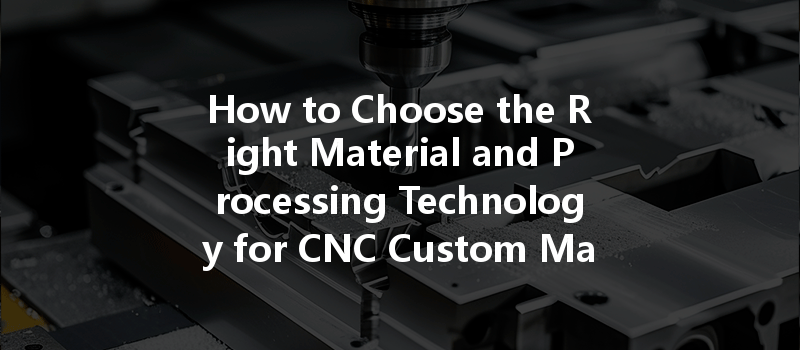Opening
Did you know that according to a recent survey, over 68% of manufacturers cite material selection as a major factor impacting the efficiency and cost-effectiveness of their CNC machining processes? The world of CNC custom machining presents an array of unique challenges, particularly when it comes to choosing suitable materials and processing technologies. Understanding your options is not merely an academic exercise; it’s a pivotal factor in selecting the right approach for your project that can save you time, money, and resources in the long run.
In this extensive blog, we will delve deep into the considerations for selecting the right material and processing technology in CNC custom machining, guiding you with detailed solutions to navigate this crucial aspect of manufacturing.
—
The Groundwork of CNC Machining
Before we jump into the specifics of material selection and processing technologies, let’s clarify what CNC (Computer Numerical Control) machining is. CNC machining refers to a manufacturing process where pre-programmed software dictates the movement of machinery and tools. This leads to precise cuts, designs, and the ultimate production of complex parts and components.
CNC machining is widely used across various industries, including aerospace, automotive, electronics, and medical devices, and its efficiency and precision have made it a staple in modern manufacturing.
—
Understanding Material Considerations
When considering what material to use for your custom machining project, it’s essential to understand the most common materials available.
Different applications have specific requirements that dictate the choice of material. Here are some crucial properties to consider:
Knowing the right application for each material can guide you towards an informed decision. For example:
—
Processing Technologies in CNC Machining
After establishing the right materials, the next step is determining the most suitable processing technologies. Here are key technologies to consider:
CNC milling uses rotating cutting tools to remove material from a workpiece, allowing for complex shapes to be manufactured with high precision. When selecting milling techniques, consider:
CNC turning is a process where the workpiece is rotated while cutting tools are applied to shape it. Important factors include:

For intricate shapes or hard materials where traditional cutting might fail, Wire EDM is an optimal choice. This technology is particularly useful for:
Laser cutting offers precision for making cuts in thin materials. Its advantages lie in:
The advent of additive manufacturing allows for even more flexibility. It is worth considering as a supplemental technology for:
—
Decision-Making Factors
When choosing materials and technologies for CNC machining, several key factors must be assessed:
Determining an effective budget is crucial, as both material types and processing technologies vary significantly in cost. Establish priorities based on the project’s overall objectives.
If timelines are tight, faster and more efficient processing techniques may be desired. CNC machining technologies, specifically those with shorter setup times, will come into play here.
It is essential to align the chosen materials and processing technologies with the quality standards required for the end product. Rigorous testing and validation protocols can determine suitability.
—
Steps for Effective Material and Technology Selection
—
The maze of material and technology choices in CNC custom machining can be daunting, yet understanding the interplay between different materials and processing technologies lays the groundwork for successful project execution. From the type of metal used to the choice of CNC technology, every decision has lasting implications on product performance, durability, and overall success.
As manufacturers face an increasingly competitive landscape, making informed choices becomes essential, not merely for the current project but also for the future scalability and adaptability of their operations. Equip yourself with the right knowledge, technology, and materials by continuously engaging with emerging industry trends to remain at the forefront of CNC machining.
In summary, this blog has outlined a comprehensive look into how to choose the right material and processing technology for CNC custom machining. From the properties and applications of various materials to the in-depth examination of processing technologies, these insights not only help in decision-making but also serve as a strategic advantage in the manufacturing realm. Thoughtfully navigating these waters can ultimately lead to better product outcomes and a more innovative approach to meeting customer expectations.






